Although Polaroid quit making film in 2009, and those last packages are now well past their sell-by date, instant photography is not a dead medium. How can you shoot instant pictures today? (Note: This post is updated regularly, as film formats go obsolete or reappear. The most recent edit was in February 2021.)
ABOUT FILM
 • Polaroid, formerly known as Polaroid Originals, previously known as The Impossible Project. Last producers of Polaroid-compatible “integral film”—that is, the format we all think of when we think “Polaroid,” the one that develops before your eyes, with the wide white frame and a squared-off tab at the bottom. When Polaroid got out of the film business, its production machines were promptly demolished, except in one factory in Holland. Literally a couple of days before it too was to be scrapped, two entrepreneur-enthusiasts swept in, bought the equipment, and started trying to make new film. They incorporated as The Impossible Project, and their task nearly lived up to its name: many of Polaroid’s supplies were simply unavailable, and they essentially had to create a new and different recipe from scratch. Their first product, launched in 2010, was sepia-toned and difficult to use; since then, every batch has shown improvement, and both color and black-and-white have become available. They are not like the old Polaroid films, which were colorfast and essentially idiotproof; among other things, Impossible’s first few generations of products had to be shielded from light for the first minute or so as they ejected from the camera. (This took a lot of the fun out of things.) After several years’ R&D, Impossible’s film improved dramatically, to the point where it looks and behaves much like Polaroid’s old product. It is imperfect but entirely usable, especially in the black-and-white version.
• Polaroid, formerly known as Polaroid Originals, previously known as The Impossible Project. Last producers of Polaroid-compatible “integral film”—that is, the format we all think of when we think “Polaroid,” the one that develops before your eyes, with the wide white frame and a squared-off tab at the bottom. When Polaroid got out of the film business, its production machines were promptly demolished, except in one factory in Holland. Literally a couple of days before it too was to be scrapped, two entrepreneur-enthusiasts swept in, bought the equipment, and started trying to make new film. They incorporated as The Impossible Project, and their task nearly lived up to its name: many of Polaroid’s supplies were simply unavailable, and they essentially had to create a new and different recipe from scratch. Their first product, launched in 2010, was sepia-toned and difficult to use; since then, every batch has shown improvement, and both color and black-and-white have become available. They are not like the old Polaroid films, which were colorfast and essentially idiotproof; among other things, Impossible’s first few generations of products had to be shielded from light for the first minute or so as they ejected from the camera. (This took a lot of the fun out of things.) After several years’ R&D, Impossible’s film improved dramatically, to the point where it looks and behaves much like Polaroid’s old product. It is imperfect but entirely usable, especially in the black-and-white version.
In 2017, the principal shareholder of Impossible bought the post-bankruptcy Polaroid, and rebranded itself under the name Polaroid Originals. (The minnow somehow has swallowed the whale.) A couple of years after that, the “Originals” suffix went away for good. Lots to see and read at the Polaroid Website.
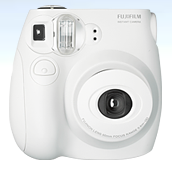 • Fujifilm Instax. Fujifilm makes a film that is more straightforwardly usable than Polaroid’s: the color is excellent, you don’t have to shield it, and it comes in three sizes. (Instax Mini makes business-card-size photos; Instax Wide is roughly the size of Polaroid’s Spectra film; Instax Square is in between, looking quite a bit like Polaroid’s classic film but slightly smaller.) The problem is that it won’t fit in Polaroid’s old cameras, and can’t be made to. (The reasons involve camera geometry, and not intellectual property as many people think; all the significant Polaroid patents on instant film are long expired.) So you have to buy one of Fuji’s Instax cameras, and they are mass-market devices, serviceable but not really up to great shooting. The Instax mini 90 is probably the best of the cameras, because it has some manual controls and a good-looking retro shell. Essentially, enthusiasts have two choices: Fuji’s reliable film in mediocre cameras, or Impossible/Polaroid’s touchy-but-interesting film in very good cameras. They each have their place, and I shoot both.
• Fujifilm Instax. Fujifilm makes a film that is more straightforwardly usable than Polaroid’s: the color is excellent, you don’t have to shield it, and it comes in three sizes. (Instax Mini makes business-card-size photos; Instax Wide is roughly the size of Polaroid’s Spectra film; Instax Square is in between, looking quite a bit like Polaroid’s classic film but slightly smaller.) The problem is that it won’t fit in Polaroid’s old cameras, and can’t be made to. (The reasons involve camera geometry, and not intellectual property as many people think; all the significant Polaroid patents on instant film are long expired.) So you have to buy one of Fuji’s Instax cameras, and they are mass-market devices, serviceable but not really up to great shooting. The Instax mini 90 is probably the best of the cameras, because it has some manual controls and a good-looking retro shell. Essentially, enthusiasts have two choices: Fuji’s reliable film in mediocre cameras, or Impossible/Polaroid’s touchy-but-interesting film in very good cameras. They each have their place, and I shoot both.
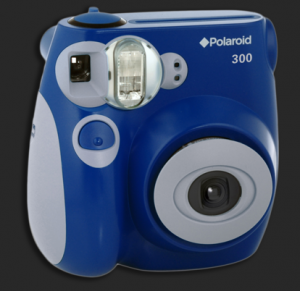 • The Polaroid 300. Yes, you can find an analog instant camera that says “Polaroid” on the front. You will note that it looks exactly the same as the Fuji Instax Mini. This is not a coincidence; it’s the same camera, relabeled. There are photography buffs who are bugged that Polaroid has thrown its lot in with Fuji, but c’mon. Anything that makes it clear that instant film is still in production, and encourages people to shoot more of it and thus keep it in production, ought to be encouraged.
• The Polaroid 300. Yes, you can find an analog instant camera that says “Polaroid” on the front. You will note that it looks exactly the same as the Fuji Instax Mini. This is not a coincidence; it’s the same camera, relabeled. There are photography buffs who are bugged that Polaroid has thrown its lot in with Fuji, but c’mon. Anything that makes it clear that instant film is still in production, and encourages people to shoot more of it and thus keep it in production, ought to be encouraged.
 • Large-format (4-by-5-inch and 8-by-10-inch) film. Large-format photography is a niche today, but its adherents are real enthusiasts. In its day, Polaroid made quite a few flavors of 4×5 film, and a few of 8×10. Until 2012, Fujifilm also made a couple (see above). They’re all discontinued now, and most stores’ stock of the Fuji material has dwindled to nothing.
• Large-format (4-by-5-inch and 8-by-10-inch) film. Large-format photography is a niche today, but its adherents are real enthusiasts. In its day, Polaroid made quite a few flavors of 4×5 film, and a few of 8×10. Until 2012, Fujifilm also made a couple (see above). They’re all discontinued now, and most stores’ stock of the Fuji material has dwindled to nothing.
Several years ago, a small Massachusetts startup called New55 began to produce an improved replacement for Polaroid Type 55—the black-and-white peel-apart film that produced both a positive and a reusable negative. Beginning with a Kickstarter campaign to finance its tooling and other initial costs, which you can read about here, the company was able to produce small quantities of pretty good film and made significant technical advances as it did, but because it was operated as a small and expensive sideline by its founders—and also hit some supplier problems—it was not able to keep going for the long haul.
However: The story does not end there! In 2019, the research done at New55 was expanded upon by a related startup, The (Famous) Large & Small Format Photography Company. TFL&SFPC has rebooted production of New55 film, with further tweaks (leading to smoother operation and better chemical spread, among other things) and a second ISO 400 line of film. We are really, really hoping it succeeds.
As for 8×10 film: The machine that produced it in Polaroid’s Waltham factory has made its way to in the Impossible Project, which saved it from the scrapheap. Impossible has run off a few batches of 8×10, using its integral-film materials, and they display a nice fine grain but are low in contrast and tonal range. They’re experimental, and (I’m told) they have not sold very well. Also, because they are–like all Polaroid integral films–exposed through the front Mylar cover, they produce a flipped image when shot in a conventional 8×10 camera. Right now, I’d say Impossible’s 8×10 is not a mature product, but that may change. If the New55/TFL&SFPC product succeeds, there is apparently a possibility that some 8×10 peel-apart could be produced on Impossible’s machinery. Fingers crossed for that.
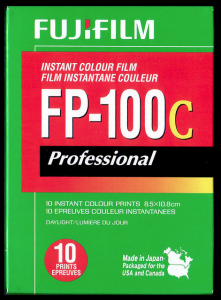 • Fujifilm pack film. Fuji has, after a long twilight, stopped making the film for 100-series pack-film cameras—that is, the models from which each photo is pulled on a paper tab, allowed to develop in a little sandwich outside the camera, and then peeled apart to reveal the print. It made the cheapest and (arguably) crispest instant pictures ever made, in part because many pack-film cameras have good multielement lenses. Pack-film backs can also be fitted onto high-quality cameras from Hasselblad, Mamiya, and many other makers. Black-and-white film in this format was discontinued in 2014, and color in 2016. A few retailers may have some of the last of it, but once it’s gone, it’s gone.
• Fujifilm pack film. Fuji has, after a long twilight, stopped making the film for 100-series pack-film cameras—that is, the models from which each photo is pulled on a paper tab, allowed to develop in a little sandwich outside the camera, and then peeled apart to reveal the print. It made the cheapest and (arguably) crispest instant pictures ever made, in part because many pack-film cameras have good multielement lenses. Pack-film backs can also be fitted onto high-quality cameras from Hasselblad, Mamiya, and many other makers. Black-and-white film in this format was discontinued in 2014, and color in 2016. A few retailers may have some of the last of it, but once it’s gone, it’s gone.
This film was also produced in larger-format packs for 4×5 view cameras (color is FP-100C45, black-and-white is FP-3000B45). Although small amounts of it show up here and there, the last batch was dated 2012, and it is now gone from most stores. (If you see any remaining, grab it fast.) It’s really a shame, because this film makes fantastic big photos, but large-format-photography enthusiasts have, unfortunately, grown used to bad news like this.
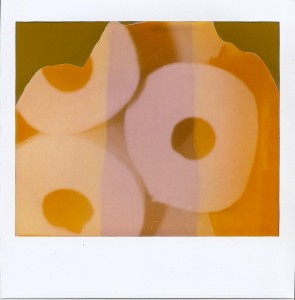 •Expired film. Unused Polaroid film—especially the color film—does not hold up well over time. The little pod of processing chemicals tends to go sour after perhaps three years. After that, the film’s color balance shifts toward yellowish-pink, then brown. Eventually, the pod starts to dry out, and the film begins to show undeveloped patches; then, finally, it won’t work at all. Storing it in the fridge extends its life significantly. (Just don’t freeze it.) Also, integral film packs contain the camera’s battery, and that too fails over time. Though it’s not my style, there are people who love the look of expired Polaroid film, and I will admit that I’ve seen some gorgeous pictures made with it. I have even made a few myself that I like, sometimes by accident.
•Expired film. Unused Polaroid film—especially the color film—does not hold up well over time. The little pod of processing chemicals tends to go sour after perhaps three years. After that, the film’s color balance shifts toward yellowish-pink, then brown. Eventually, the pod starts to dry out, and the film begins to show undeveloped patches; then, finally, it won’t work at all. Storing it in the fridge extends its life significantly. (Just don’t freeze it.) Also, integral film packs contain the camera’s battery, and that too fails over time. Though it’s not my style, there are people who love the look of expired Polaroid film, and I will admit that I’ve seen some gorgeous pictures made with it. I have even made a few myself that I like, sometimes by accident.
ABOUT OLD POLAROID CAMERAS: A FORMAT-BY-FORMAT GUIDE
If you’re not going the Fuji Instax/Polaroid 300 route, you need an old Polaroid camera. Polaroid produced nine principal formats (aside from the professional ones), four of which still have film available from the sources above. You can do research far beyond the scope of this site at Instant Options, and you should consider the guide here a quick-start digest. On this list, green means you can still get film for it; red means you’re out of luck.
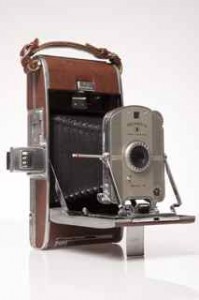 •Rollfilm cameras/Series 40 film. The true originals, produced 1948-1963. They’re pretty; they’re big and heavy; and virtually all of them are doorstops. Film was discontinued in 1992. Some folks, including Instant Options, offer a conversion service wherein a newer back that takes available film is grafted onto these old guys. (The Polaroid Model 110A and 110B, which have the best lenses, are the prime candidates here.) When converted well, they are really fine cameras, and they cost a lot. I have one, and I love it. So do a lot of people who encounter it on the streets of New York.
•Rollfilm cameras/Series 40 film. The true originals, produced 1948-1963. They’re pretty; they’re big and heavy; and virtually all of them are doorstops. Film was discontinued in 1992. Some folks, including Instant Options, offer a conversion service wherein a newer back that takes available film is grafted onto these old guys. (The Polaroid Model 110A and 110B, which have the best lenses, are the prime candidates here.) When converted well, they are really fine cameras, and they cost a lot. I have one, and I love it. So do a lot of people who encounter it on the streets of New York.
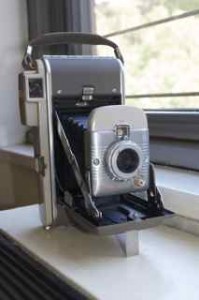 •Rollfilm cameras/Series 30 film. The little sisters to the 40-series cameras: similar but smaller, with correspondingly smaller photos. Most common are the Model 80 and 80A, also called the “Highlander.” Plentiful, attractive, and also defunct, as film disappeared in the nineteen-seventies.
•Rollfilm cameras/Series 30 film. The little sisters to the 40-series cameras: similar but smaller, with correspondingly smaller photos. Most common are the Model 80 and 80A, also called the “Highlander.” Plentiful, attractive, and also defunct, as film disappeared in the nineteen-seventies.
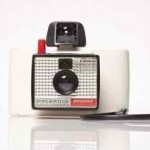 •Rollfilm cameras/Series 20 film, a.k.a. “The Swinger.” This one was a favorite of baby-boom teenagers, to whom it was aggressively marketed starting in 1965. It made very small photos, and only black-and-white film was available. Groovy white mod design; sadly, also dead. Film ceased production around 1975 or so.
•Rollfilm cameras/Series 20 film, a.k.a. “The Swinger.” This one was a favorite of baby-boom teenagers, to whom it was aggressively marketed starting in 1965. It made very small photos, and only black-and-white film was available. Groovy white mod design; sadly, also dead. Film ceased production around 1975 or so.
•Pack-film cameras/series 100 film Introduced in 1963; Fuji’s last pack film was made in 2016. If you happen upon any of this film that’s still usable, look for a Model 180, 185, 190, or 195 camera: Those are the all-manual professional models, and in good condition, they command high prices on eBay ($500-ish and up). Things to look for include a bellows that does not have pinholes at the corners; a battery compartment that is not full of corrosion and gunk; and an interior that’s not rusting. For much more about these, including details about the weird batteries some of these models require, I refer you, again, to Instant Options.
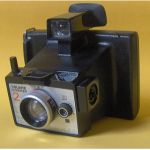 •Pack-film cameras/Series 80 film. Another junior line, using the same film stock in a smaller-and-cheaper pack that produced square pictures. Commonest camera is probably the one called the Square Shooter 2. Film got doinked in 2006. A shame, because the square format has a lot of charm.
•Pack-film cameras/Series 80 film. Another junior line, using the same film stock in a smaller-and-cheaper pack that produced square pictures. Commonest camera is probably the one called the Square Shooter 2. Film got doinked in 2006. A shame, because the square format has a lot of charm.
•Integral film: SX-70. The superior version of the classic Polaroid camera, introduced in 1972. White polyester frame on each picture with a wide tab at the bottom; spits out the front of the camera after you press the button. The most coveted of these cameras are the folding, leather-covered original SX-70 and its successor, the SX-70 Alpha 1, which can make very fine photographs. The SX-70 Model 2 is similar but slightly less well finished, with vinyl in place of the leather and plain ABS plastic instead of brushed chrome. All three are SLR cameras (that is, the view through the viewfinder is through the lens, an arrangement that depends here upon an absolutely amazing bit of optics engineering). There is also an SX-70 Model 3, which is less desirable because it’s not an SLR—it’s focused by guesswork.
 This category further includes many of the one-piece plastic cameras marketed at various price points as the Pronto!, the Button, the Model 1000, and, most of all, the OneStep. They are incredibly plentiful and reliable, and they can make pretty good pictures, particularly when the subject is neither too close or too far (about 6 feet away is best). Film for these is available from Polaroid, formerly known as the Impossible Project, in black-and-white and color varieties, as described above. Rated film speed is about ASA/ISO 100.
This category further includes many of the one-piece plastic cameras marketed at various price points as the Pronto!, the Button, the Model 1000, and, most of all, the OneStep. They are incredibly plentiful and reliable, and they can make pretty good pictures, particularly when the subject is neither too close or too far (about 6 feet away is best). Film for these is available from Polaroid, formerly known as the Impossible Project, in black-and-white and color varieties, as described above. Rated film speed is about ASA/ISO 100.
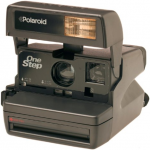 •Integral film: Type 600. The successor to SX-70: same format, much faster (ASA/ISO 600). Most of these cameras are the plastic one-piece type with the flip-up flash. They are, like the earlier OneStep, not fantastically versatile photographic instruments, but they are sturdy useful workhorses, and there are literally tens of millions of them out there in the world—hit three yard sales some spring afternoon, and odds are you’ll get one. If you are very lucky, you may happen upon the folding SLR 680 or SLR 690, the superb autofocus models that take 600 film (and command a few hundred dollars on eBay). Polaroid makes 600 film in black-and-white and color.
•Integral film: Type 600. The successor to SX-70: same format, much faster (ASA/ISO 600). Most of these cameras are the plastic one-piece type with the flip-up flash. They are, like the earlier OneStep, not fantastically versatile photographic instruments, but they are sturdy useful workhorses, and there are literally tens of millions of them out there in the world—hit three yard sales some spring afternoon, and odds are you’ll get one. If you are very lucky, you may happen upon the folding SLR 680 or SLR 690, the superb autofocus models that take 600 film (and command a few hundred dollars on eBay). Polaroid makes 600 film in black-and-white and color.
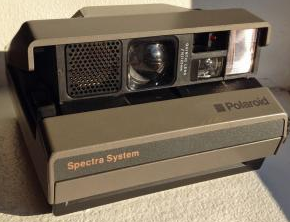 •Integral film: Spectra. The wider-format version of 600 film, for the electronics-heavy cameras introduced in 1986 and produced for two decades. These cameras have good lenses and (arguably) better exposure controls than the earlier cameras. Some people seem to prefer a model called the Spectra Pro, though most Spectras seem about the same to me, as long as they work. Polaroid very recently quit making Spectra film, claiming that the cameras themselves are beginning to age out of repairability. I suspect (but have not confirmed) that Spectra’s relatively smaller fan base probably made it difficult to justify the production runs.
•Integral film: Spectra. The wider-format version of 600 film, for the electronics-heavy cameras introduced in 1986 and produced for two decades. These cameras have good lenses and (arguably) better exposure controls than the earlier cameras. Some people seem to prefer a model called the Spectra Pro, though most Spectras seem about the same to me, as long as they work. Polaroid very recently quit making Spectra film, claiming that the cameras themselves are beginning to age out of repairability. I suspect (but have not confirmed) that Spectra’s relatively smaller fan base probably made it difficult to justify the production runs.
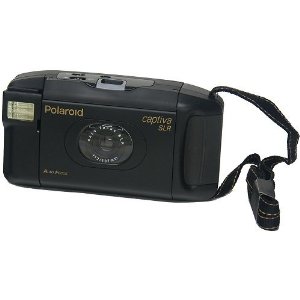 •Integral film: Type 500. The principal camera using this format is the Captiva SLR, produced in the early 1990s. It was a supposed to revive the instant-film business, and didn’t. A few low-end cameras, including the embarrassingly cheap JoyCam, used this format as well. It was smaller than SX-70/600 film, making photos a little larger than a credit card. Discontinued in the mid-2000s.
•Integral film: Type 500. The principal camera using this format is the Captiva SLR, produced in the early 1990s. It was a supposed to revive the instant-film business, and didn’t. A few low-end cameras, including the embarrassingly cheap JoyCam, used this format as well. It was smaller than SX-70/600 film, making photos a little larger than a credit card. Discontinued in the mid-2000s.
 •Integral film: i-Zone. A tiny camera, about the size of a desk stapler, that took even tinier photos: an inch by an inch and a half, barely larger than a driver’s-license picture. These cameras were unmotorized; you pulled the film out on long paper tabs. It was a hit among teenagers around 1999 or so, and Polaroid quickly introduced a nifty version of the film that had peelable sticker backs, for decorating notebooks and school lockers and the like. Regrettably, teens are fickle, the craze burned itself out, and the film went away soon thereafter.
•Integral film: i-Zone. A tiny camera, about the size of a desk stapler, that took even tinier photos: an inch by an inch and a half, barely larger than a driver’s-license picture. These cameras were unmotorized; you pulled the film out on long paper tabs. It was a hit among teenagers around 1999 or so, and Polaroid quickly introduced a nifty version of the film that had peelable sticker backs, for decorating notebooks and school lockers and the like. Regrettably, teens are fickle, the craze burned itself out, and the film went away soon thereafter.
36 Responses to Instant Photography Today
Leave a Reply Cancel reply
LEGALITIES
This site is not connected with or endorsed by Polaroid or PLR IP Holdings, owners of the Polaroid trademark.ON TWITTER
My TweetsBlogroll
- 'Insisting on the Impossible'
- Everything Reminds Me of You
- Flickr's Polaroid group
- Instant Options
- LandCameras.com
- Paul Giambarba: Analog Photography At Its Best
- Paul Giambarba: The Branding of Polaroid
- Polaroid
- Polaroid SF
- Rare Medium
- The Impossible Project
- The Land List
- The New55 Project
- Vintage Instant

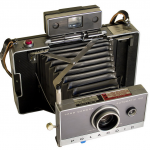
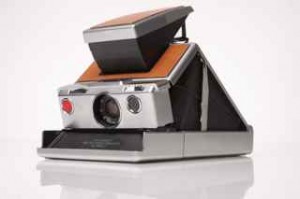
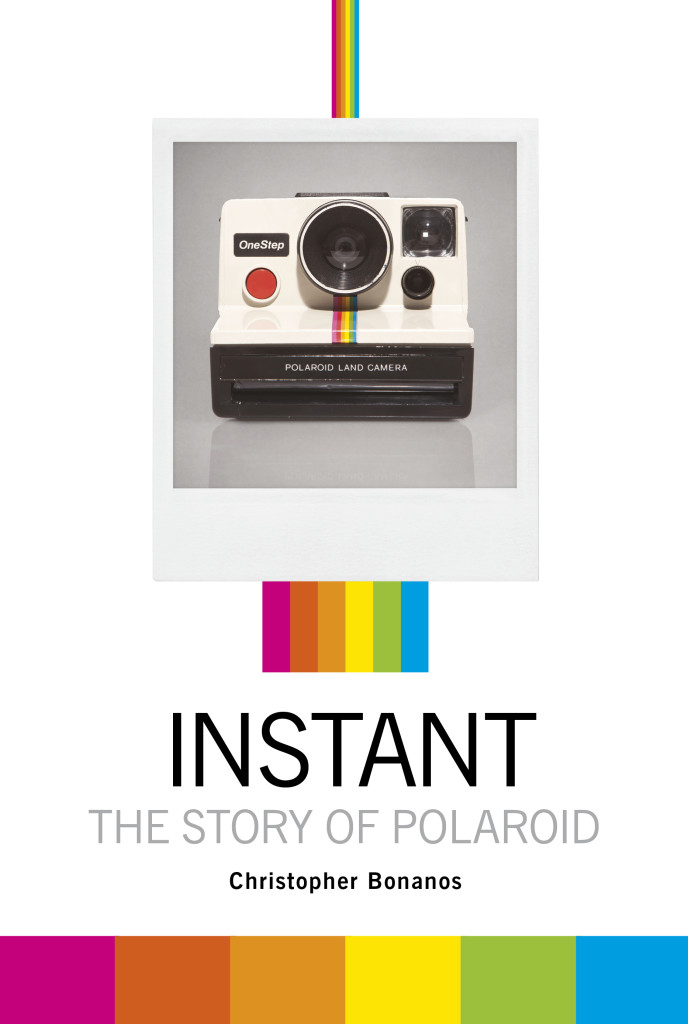
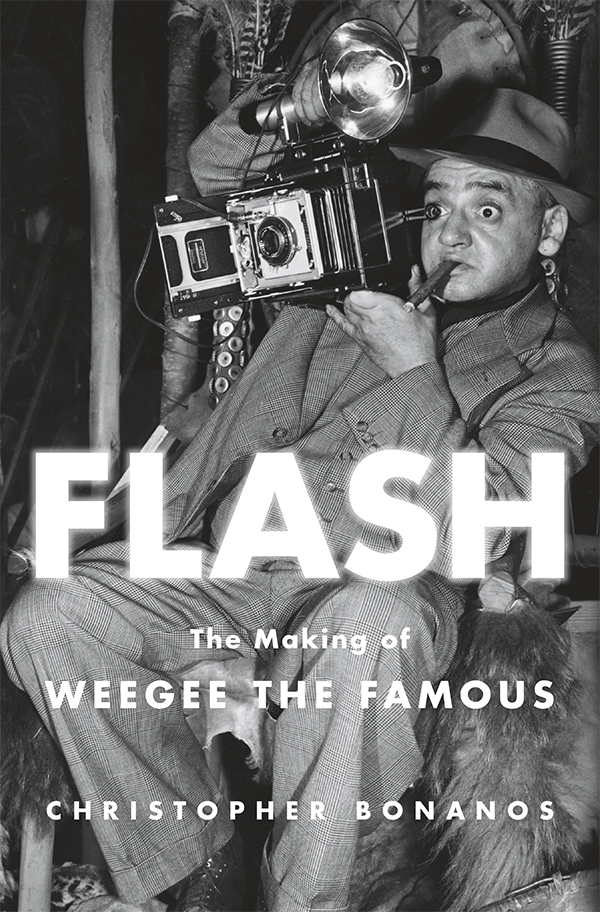


[…] Instant Photography Today: A Guide […]
Thanks for the links, always glad to help instant photography!
Thank you for this informative article, it is appreciated. I have a model 103, an SX-70 camera, and a Spectra camera, and thanks to this article, I can buy film for all of them. Remember: unlike a digital camera, the Polaroid photograph shows “the truth”, you can’t manipulate the photo or alter a negative!
The problem with the Impossible film is that it is very unreliable, even if you follow instructions. I have found that if you shoot indoors without a flash, the results are extremely poor. Outside, the film needs to be shielded in spite of Impossible’s claims that the latest Color Protection film does not need shielding.
Also, there is the issue of undeveloped patches on this film. This is especially true foe the folding cameras such as the SX-70 and slr 680. I own an SLR 690, and three packs of my Impossible Project film were ruined with these horrible undeveloped patches. I suspected something may be wrong with my camera but no, it worked with expired Polaroid film.
Impossible are certainly giving these old cameras a new lease of life but I do wish Fuji and Polaroid join forces to make a polished product because with Fijifilm’s expertise in film production, they are far likelier to come up with superior film. There Instax film produces much better results than the original Polaroid 600 film. The 600 only produced good results with the SLR cameras. The rest were only of snapshot quality. Today’s hipsters are gascinated by thebPolaroid cameras and instant photography but during its lifetime serious photographers were unlikely to touch them with a barge pole. It is also true that, though some people have used Polaroid artistically, the images they produce were never considered to be great. Yes, some artists used them and they are fun, but some artists also use toy piano’s as a novelty and that is what Polaroid is. I think as long as they know this, they will have fun. However, this sort of fun can cost quite a lot and the Impossible film is so unreliable, even the fun will fizzle out.
The best bet is to get the old pack film cameras. The film is relatively cheapbandbproduces better results than the Impossible film. The Fuji pack film is beautiful and rather than waste money on crappy Impossible products, it makes more sense to spend the money on the Fuji stuff which is very well made and more reliable. If hipsters support Impossible, in the misguided belief that this company is saving instant photography, they will do so at the deriment of instant photography because if Fuji stop making the only decent instant film left, photography fans will be left with the crap made by Impossible.
I agree with you about the Impossible film quality however I think the artist
Stefanie Schneider has done much especially with expired Polaroid film in her film “The girl behind the white picket fence”. The first polaroid movie ever.
Did you get any undeveloped patches with your slr 680? I get them everytime on my 690. I didn’t get them with my first Impossible film pack but all subsequent film packs have had this problem and I don’t have a faulty camera since this issue is well documented and there is even information on it on the Impossible website. Their so-called fix does not seem to work for most people. The technique requires putting pressure on the film door, but over time thisbmay cause the camera mechanical damage. Changing the film door with an SX-70 door is another ootion but you will need a spare sx-70 or the part. As these slr’s are considered to be some of the best polaroid cameras made, it is somewhat sad that the Impossible film has issues with theelse cameras. I really hope they improve their film so at least it works with these camras without major issues.
I just picked up a square shooter 2 camera today. Does it use the same peel apart film that Fuji makes? The Fp-100 c?
Unfortunately, no. It takes a smaller version of the peel-apart film, in a square format, that was discontinued around 2006. If you find any of the final production run, it may still sorta work, but that’ll be the end of it.
The color film was sold under the name Viva at the end, and as Type 88 before that; the black-and-white version was Type 87.
Hi! I got a copy of your book last week and it brought me here; I know there’s a ton of info on Polaroids in English but I have taken it upon myself to ‘educate’ the Spanish-speaking online community through my blog. I own a few cameras (600SE, Mamiya RB67 with instant back, SX-70 Alpha-1, Land 101) and I try to share as much as I can through my blog in Spanish, all the way from Chile. Are there any plans to translate the book? I know lots of people who’d read it if it weren’t in English. Cheers!
There are translated editions for the Far East in the works: Chinese, Korean, and possibly more. Not sure about Spanish, but I’ll ask the publishers.
Well, now that I finally had the time to finish the book I can gladly say that I would LOVE to translate it; what did the publishers say?
A friend just gave me a pack of 668 film. It expired 1995 but has been fridged since then. I have a square shooter and a colorpack II. Would the 668 film fit in one of the cameras I have? Thank you.
It will fit in the Colorpack II. Try it! Might work, might not–after nearly twenty years, the pods are likely to be dried up, but pack film outlasts the integral film, and you might get something pretty.
Just make sure you put fresh batteries in the camera. I think they’re in front of the film plane in a Colorpack II, so you can’t change them once you’ve loaded the film pack into place.
is there any fuji film that might fit my spectra 2?
No. Spectra and Fujifilm cameras use different-sized film, and expose the film through opposite sides (Polaroid from the front, Fuji from the back). The only available film that will work in your camera is made by Impossible.
IMPOSSIBLE Film, not only expensive, is unstable as well. Unlike Fuji FP100-C, the humidity affects its development and it longevity. As mentioned in the article, it’s light sensitive upon immediate exposure, thus having to cover the image as soon is it is ejected.
I have used many packs of film and I’m going to wait until IMPOSSIBLE or some other company comes up with something more stable, especially because of the cost per photo: @USD $2.50 each shot.
I heard a rumor there will me a new film that doesn’t require the film to be covered upon exposure….hope so!
So, until then, I’m loving my Land Camera with Fuji film!
Enjoy!
I am looking for history on Newsletter called ‘Polaroid Pointers”, that was published by Polaroid around 1950’s?
Thank you.
New to me. The only Polaroid-photo-tips newsletter I know about was called “Minute Maker,” and was published in the mid-fifties. I have a few copies, and will upload scans if you’d like to see them.
hello!
While tiding my seller i have found an polaroid supercolor 1000.
You say the only suitable films are those sx70, aren’t they?
In my opinion they have turnend to be pretty expansive! I once paid 10€ per 10 films, nowadays you pay ~20€ per 8! Aren’t there any similar films, made by other companies which suit as well? thanks a lot!
Unfortunately, the Impossible Project’s film is your only option. The film is expensive mostly because Impossible is a small and fairly new company, without Polaroid’s economies of scale.
okay, thank you a lot also for answering quickly!!
Just found a Polaroid 80B Highlander…no film options available at all ?
Nope. Wish it were, but film for the Highlander has been unavailable for about 35 years. Anything that’s left, even if it’s sealed in its packaging, is dried-up and dead.
Enjoy the camera as a handsome decorative object. Makes a nice bookend.
FUJI FILM FP-100c:
The film pack is a bit of a hassle being Fuji has chosen to put 10 pictures into a film pack designed for 8. My first experience with the film pack was terrible. Could not pull the protective black sheet out of the camera; it kept tearing. Than could not pull the wihite tabs out of the camera. Thought the film pack was defective. Got another pack with the same problem. Went on line and was instructed to take out the springs from the camera door as they are pressing on the film pack, made of plastic instead of the original Polaroid film pack made of metal. Also remove the timer, if the camera has one on the door. Than I found out you could just replace the plastic backing of the Fuji film pack with the metal one from an old Polaroid film pack. Tried that and it worked perfectly. As for the picture quality all I can say is that it is outstanding. Better than the original Polarcolor film. For outdoors I had to turn the lighten darken control all the way for light to get a decent picture. Indoors, with a flash I had to turn one notch to lighten. Again the results were fantastic. Hope Fuji continues to make this great film for the Polaroid camera. My Polaroid 360 electronic flash camera is back in action. Better than ever.
I’ve found that mashing down the springs in the back, rather than breaking them off, is enough to do the job. But I haven’t tried this with any of the pack cameras that have the timer built in, and that may make the back a little thicker, so your mileage may vary.
Also, it helps to pull the black darkslide slightly before you close the camera back. Just half an inch or so, to get it loose.
So, if I have a square shooter 2, should I just throw it away? Is it worth anything when film is no longer available?
It’s no longer a useful camera, but there are people who like these as decorative objects. The rollers, inside, are also useful as parts, in other cameras that are still active. I would send it to the local thrift store instead of throwing it out.
Does anyone know whether you can still get film for a Polaroid 561/8617 camera, and if so, where from? Thanks
Type 600 film, from the Impossible Project (see above), will fit that model.
The peel apart film, made by Fuji, is being discontinued. Most places have sold out already and most places have jacked up the prices 2 fold so I am out on that. I just picked up some instax film and will of the impossible project.
Yes–I’ll be updating the page shortly.
But do bear in mind that there will be another shipment coming in from Japan for those of us who wish to stock up.
And the prices will still be highly marked up, so again, I will not pay that,
I sold my Polaroid pack film camera literally a. Few months before the film was discontinued. I had a feeling the plug was about to be pulled. I used up the last batch of film I had and then put the camera up for sale. I was sad to sell the camera because the Fujifilm FP-100c was a great product and it was relatively easy to use compared to the original Polaroid film. It was better than Instax and way better than the rubbish the Impossible Projects rebranded Polaroid company make. Even with the Polaroid SLR cameras, you can get great or consistent results and there is no point in having a great Polaroid camera, using very expensive film, and getting mediocre results. Instax Wide is probably the best option now. I wish Fuji could have continued making the film but it was quite obvious then that Fuji were putting all their marketing efforts to promote Instax. I am glad I was able to get a good price for my camera, and I was happy I used FP-100C before it was discontinued. I have some terrific photos, which are pin sharp and have a vintage quality to them. RIP FP-100C.
Fujifilm has announced end if FP100c production so all the Polaroid land cameras are worthless very soon.
Alas, it appears that Impossible/Polaroid discontinued production of the Spectra film at the beginning of this year. My old camera is a paperweight again.